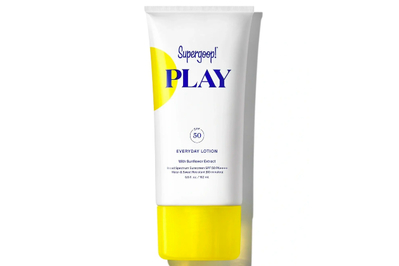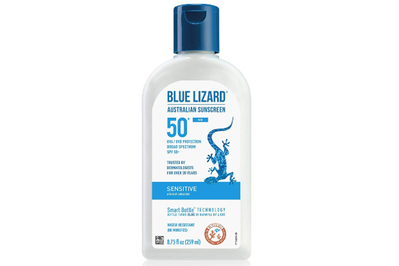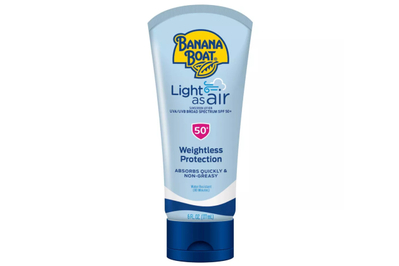Ask Wirecutter: What’s the Best Way to Pack Sunscreen for Vacation?

Annemarie Conte is an editor who writes the Ask Wirecutter column and trending-product reviews. She’d love to make you a friendship bracelet.
Welcome to Ask Wirecutter, where deputy editor Annemarie Conte helps you figure out how to make the most of your stuff in real life. If you have a shopping conundrum for our advice columnist, submit it using this form.
Dear Wirecutter,
I’m getting ready for a family vacation, and packing sunscreen is really stumping me. Do I check bags to be able to bring larger bottles? Or should I just buy it at our destination?
K.T.
Dear K.T.,
The Transportation Security Administration’s rules regarding liquids have really put a wrench in the easy-breezy decision-making of packing for vacation. In the past I’ve filled my checked bag with so many bottles of sunscreen for my family of four that either we end up leaving them at our destination or I repack the extras at the end of the trip and bring them home, having given my Banana Boat a transcontinental getaway.
You need to check a bag if you want to bring more than 3.4 ounces of liquids, a category that includes sunscreen lotions and sprays, and your focus should be on ensuring that it reaches your destination intact.
But if you’re not checking a bag, you have a few creative options to ensure a sun-safe holiday. Here’s our best advice.
Advertisement
SKIP ADVERTISEMENTBring protective clothing
Before we get into sunscreen math, consider protective clothing—UPF clothing, but also hats and sunglasses—for adults and kids alike.
“The best strategy is to minimize exposure to sun overall, especially in the hours around noon,” cosmetic chemist Kelly Dobos told me in an email interview.
UV levels are at their highest midday since that’s when the sun is at its highest and its rays have the shortest distance to travel through the atmosphere, according to the Environmental Protection Agency (PDF).
Calculate the amount of sunscreen you need
To decide how much liquid sunscreen to bring, consider the standard guidance for sunscreen application, which is to apply 1 ounce every two hours or after swimming or vigorous exercise.
Multiply the number of applications per day by the number of days of the trip to get your total application needs per person. For example, if you are going on a three-day trip and expect to be in the sun for six hours each day, the calculation is 3 ounces per day multiplied by three days, which equals 9 ounces of sunscreen per person. Then round up for good measure.
The TSA limits liquids at 3.4 ounces per container for carry-on. For checked bags, each container must not exceed 17 fluid ounces. Meanwhile, the “total aggregate quantity per person cannot exceed … 68 fluid ounces.”
If you were to bring the limit, that would amount to 68 applications per adult, which is more than enough for the average American’s trip. Your choices now are either to pack the sunscreen or buy it at your destination (or both!).
Advertisement
SKIP ADVERTISEMENTStash facial sunscreen in your carry-on
Our pick
This moisturizing sunscreen is lightly scented and leaves a nice, dewy finish. It’s thick, though, and some testers had a hard time rubbing it in.
This formula is designed for the face and body. It rubs in easily and appears nearly transparent once applied. It has a light, pleasant scent and also comes in a large jug that’s relatively affordable on a per-ounce basis.
All of Wirecutter’s picks for the best face sunscreens come in packaging small enough to meet the TSA’s in-cabin requirements. Bringing facial sunscreen ensures that you have a sunscreen you prefer to use on one of the more-sensitive areas of your body (don’t forget to put it behind your ears and on your décolletage too).
Stick sunscreens also usually fall under the 3.4-ounce limit, so they would be let through in carry-on luggage as a liquid. Sticks are not ideal for full-body sunscreen application, but they can be useful for on-the-go reapplication.
If you need to transfer a small amount of sunscreen to another container, a general rule of thumb is to use the decanted sunscreen within a week or two, according to Dobos. Whenever possible, and especially over longer periods, it’s best to leave sunscreens in their original packaging, in part to reduce the risk of microbial contamination.
You may have seen posts on social media suggesting that you should never decant sunscreen from its original bottle into another container because doing so can make the sunscreen less effective. More research is needed to determine whether transferring a specific sunscreen to different containers—of varying materials, for different amounts of time, and with exposure to different environmental conditions—materially affects that particular formula.
If you’re not checking a bag, decanting larger bottles of your favorite body sunscreen into 3.4-ounce increments to carry on might be tempting, but for anything longer than a weekend trip, it’s probably not worth the effort. The TSA’s liquid limit for carry-on amounts to only three full-body sunscreen applications, and bringing multiple small containers for multiple people over multiple days (see the math above) is, well, a lot. It’s better to simply bring a larger bottle in your checked bag or to buy sunscreen at your destination.
Bigger bottles can go in your checked luggage
Our pick
This physical sunscreen lotion absorbs easily and is free of added fragrance. Although it can feel greasy and leave behind a white cast, it’s less visible on skin than most physical sunscreens.
This easy-to-apply lotion lives up to its name, as it rubs in with a dry, transparent finish and appears nearly colorless on skin. It has added fragrance but not an overpowering sunscreen scent.
Buying Options
Even if you’re checking a bag, it’s still a good idea to pack your facial sunscreen (or any smaller-size bottles of body sunscreen) in your carry-on so that it stays with you and doesn’t go missing if your luggage is lost.
I asked Wirecutter staffers about how they pack bottles of their favorite body sunscreen to reduce the chance of leaks. (If you’re going somewhere ocean-adjacent, you may want to consider bringing a reef-safe sunscreen as well.)
One handy trick is to wrap the bottles in a bandana or a microfiber cloth, since the material will soak up any spills and can easily be hand-washed in a hotel-room sink.
You can then slide the bundle into a zip-top bag for safety so that any leaks are contained to the bag—and don’t end up all over your favorite breezy linen shirt.
Things get slightly more complicated if you’re trying to pack a pump bottle (I’m a huge fan of the 18-ounce Supergoop Play Everyday Lotion SPF 50), since you have to worry about closing and locking the pump in place and then taping or rubber-banding it closed to try to prevent it from popping open. For this reason, I think bottles with screw tops or snap-close caps are a better choice.
Advertisement
SKIP ADVERTISEMENTBuy sunscreen at your destination
If you’re not checking a bag or don’t want the hassle of packing your sunscreen, purchasing at your destination is the way to go. Hotel and resort gift shops are often pricey, but you can try getting your sunscreen at a local grocery store instead.
You may not have a choice of your favorite brands, though, and in that case it’s time to read some labels. Look for a “broad spectrum” sunscreen labeled SPF 30 or above, per American Academy of Dermatology recommendations.
Ship it ahead of time
If you have allergies or other considerations that restrict you to using products with specific ingredients, you may be able to ship your preferred sunscreen to your accommodations. Call the hotel concierge or property owner to find out the best way to have your items delivered.
I know that all of this prep work may sound daunting, but a fun and sun-protected vacation is worth the effort. Have a great trip!
This article was edited by Jason Chen.
Advertisement
SKIP ADVERTISEMENTMeet your guide
Annemarie Conte is a deputy editor at Wirecutter. She has written and edited for multiple local and national magazines throughout her career. You can follow her on Instagram.
Advertisement
SKIP ADVERTISEMENT




